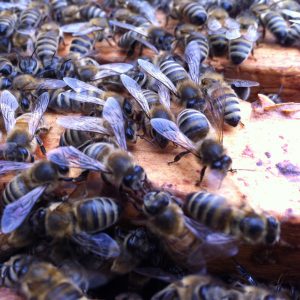
![]()
Written by: Dr. Alison McAfee, Postdoctoral Fellow, Foster Lab (right)
Edited by: Aparna Gopal, PhD Candidate, Karsan Lab (left)

In-person meetings are valuable for making connections and exchanging knowledge, but we should rethink our travel priorities in light of the climate crisis.
The Entomological Society of America (ESA) conference in Colorado, Denver, was among the first of the in-person conferences since the beginning of the COVID-19 pandemic. Between October 31st and November 3rd, 2021, a few hundred delegates gathered at the Colorado Convention Center to present their latest research on everything to do with insects. Although this turnout was a far cry from the ESA meeting I attended in 2013, which had several thousand attendees, somehow the small size of this meeting was still a bit overwhelming.
To exchange knowledge and network in person was refreshing, but the hybrid in-person and virtual format had some advantages as well. The hybrid format allowed some talks to be live-streamed to attendees at home, and many other talks were uploaded and accessible for review in the weeks following the conference. I found this feature to be invaluable, as there are only so many talks a person can attend in a day without succumbing to the usual “conference burnout.”

Worker bees. Photo by Dr. Alison McAfee.
With my attendance supported by a CBR Travel Award, I presented my recent research on drone (male) honey bee sensitivity to abiotic stressors, including temperature and pesticide stress. I showed that, in a series of survival challenges, drones are disproportionately sensitive to hot and cold temperatures, as well as imidacloprid (a common insecticide) compared to females. Using proteomics, I showed that male and female bees have strikingly different expression patterns of proteins linked to stress responses.
The temperature sensitivity of male bees is particularly worrying, since extreme weather events such as heat waves, with which we are now all too familiar, are only expected to increase in frequency and severity. Here in B.C., some beekeepers observed the direct effects of extreme temperatures when they saw dead drones in their apiaries after the heat wave last June, which may have influenced their concurrent poor queen mating success.
For me, the most impactful session of the conference was on “Understanding and responding to insect declines.” The talks in this session covered diverse topics including the impacts of invasive species, droughts, and other effects of climate change on insects, including heavier temperate winter rains and flooding of native bee nesting sites. As a honey bee fertility researcher, I am concerned that many of the factors affecting honey bee reproduction may also be detrimental to the native species.
Like a premonition, just two weeks after the ESA meeting concluded, record-breaking rainfalls flooded many parts of southern B.C., and now I am worried about the ground-nesting bees hibernating on the flood plains. This is just one of a series of extreme weather events we have experienced in B.C., which we should expect to encounter more often as the climate continues to change.
Many of us are thinking about individual actions we can take to help reduce our carbon footprints. Despite the professional benefits of in-person meetings and our desire to alleviate COVID-19 cabin fever, with the high carbon emissions associated with flying and extreme local environmental disasters, we should rethink if our desire to network in-person is really worth it.
Photography by Dr. Alison McAfee.
CBR Travel Awards are open to graduate students, postdoctoral fellows, research associates and clinical trainees in a lab or clinic directed by a CBR Principal Investigator. Learn more about the CBR Travel Award and how to apply.


